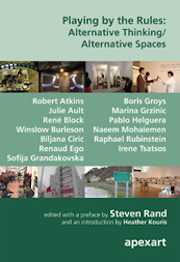Publications
Playing by the Rules: Alternative Thinking/Alternative Spaces
With new essays by: Robert Atkins, Julie Ault, Rene Block, Winslow Burleson, Biljana Ciric, Renaud Ego, Sofija Grandakovska, Boris Groys, Marina Grzinic, Pablo Helguera, Naeem Mohaiemen, Raphael Rubinstein, Irene Tsatsos
Edited by Steven Rand and Heather Kouris
published by apexart
ISBN: 978-1933347431
paperback, 176 pages
Release date: August 2010
Preface by Steven Rand - download pdf |

|
The perceived rules of the development and running of alternative spaces, and where those rules came from, are among the questions answered by the authors of Playing by the Rules: Alternative Thinking/Alternative Spaces. The underlying message in the publication is the importance of critical thinking as well as the need for alternative thinking. Some authors use specific examples of alternative spaces from around the world to demonstrate the varied thinking in organizations; some examine alternative practices in other fields, while other authors present alternatives to the alternative space. We hope this collection of essays will provide some inspiration in your own critical thinking and give you some fresh perspectives.
Drawing on his experience as an artist and the Founder and Executive Director of apexart, Steven Rand’s preface to Playing by the Rules addresses the role of the alternative space and the need for alternative thinking to challenge some of the art world’s practices and the ways apexart has tried to address them over the last 16 years.
A few of the essays provide some history of alternative spaces. Robert Atkins (art historian, critic, and curator based in California) uses as an example the salons of the 1920s, specifically Mabel Dodge’s, to show how a true alternative functioned; even such an old model can still hold relevance today. Questioning the value of history, Atkins calls alternatives in general “the impetus for change.” René Block (gallerist and former director of the Kunsthalle Fridericianum in Kassel, Germany) gives a brief history of how alternatives began and an introduction to TANAS, a private organization in Berlin with funding from Turkey intended to provide opportunity to Turkish artists in Germany. Using case studies of art venues in China, Vietnam, and Cambodia over the last 20-30 years, Biljana Ciric (independent curator based in Shanghai) explores the potentials of alternatives in these locations, and the importance of connecting with the rest of the world. Ciric outlines how these venues are developing the infrastructure missing from these locations and working towards a more long-range view necessary for progress as well as a place for intellectual exchange.
Other essays use other alternatives as example. Irene Tsatsos (writer and curator and former Executive Director of Los Angeles Contemporary Exhibitions) uses examples of permaculture housing as alternative living arrangement and Matta-Clark’s restaurant Food as alternative venue in the 1970s to demonstrate the importance of critical thinking and unrestrained creative expression. Marina Grzinic (philosopher, artist and theoretician based in Ljubljana) presents the construction of “normality” to help define alternative. She suggests that few alternative spaces and alternative radical practices exist because they are not viewed as they once were. She uses necropolitics as an example of alternative practice and gives specific examples of “alternative radical practices” in the social/political realm. Naeem Mohaiemen (writer, artist, and technologist working in Dhaka and New York) uses as main example the Paris exhibition of works from Bangladesh to show how an alternative approach to standard procedure is necessary. When the Bangladeshi people resisted a loan they saw as theft, their actions ended up changing the way art is exchanged.
Some essays reaffirm the importance of thinking critically. Sofija Grandakovska (academic, theorist, and poet in Skopje) uses the dissident, one who is inherently full of conflicts, as an example to explore the importance of critical thinking and searches for the alternative space for the dissident. Julie Ault (artist, writer, and editor based in New York) reviews her previous writing on alternative spaces and shares the importance of “reflexivity” in continually asking what we are doing and why. Winslow Burleson (Assistant Professor of Human Computer Interaction at Arizona State University; received his PhD from the MIT Media Lab) shares his work in the field of Human Computer Interaction to present a series of motivational tools and approaches for young people working in the arts today, such as “define success personally” and “seize the opportunity to fail.”
Some texts reveal ways to achieve a “new” alternative space. Renaud Ego (poet based in Paris) shows the alternative aspects in the field of writing and mentions technology, specifically the Internet, as a revolutionary method as it provides a place to be free to express oneself to the masses. Boris Groys (philosopher, essayist, art critic, media theorist; previously Professor of Aesthetics, Art History, and Media Theory at the Center for Art and Media Technology; now professor at New York University) also explores the power of the Internet as he argues that the de-professionalization of art is a “highly professional operation” and further that weak images have the most power. With the accessibility of the Internet, coupled with our lack of time, we don’t necessarily need to see a perfect work or text; it is enough to know that it exists somewhere out there.
The future of alternative spaces may lie in a non-venue. Pablo Helguera (artist and Director of Adult and Academic Programs at the Education Department of MoMA, NY) suggests we ought to (re)consider our audience and that perhaps the public program and a traveling venue is a more appropriate approach to reaching current audiences. Raphael Rubinstein (New York-based poet and art critic and past editor at Art in America) reviews some of the changes that have evolved since alternative spaces began in the 1970s, including the market acceptance of “alternative” art, creating a situation where commercial galleries began showing work that was as “cutting edge” as the “true” alternative spaces. Rubinstein suggests a changing location as a better way for alternative spaces to adapt to change—especially considering the nomadic nature of our existence—and outlines specific examples of this approach.
|





